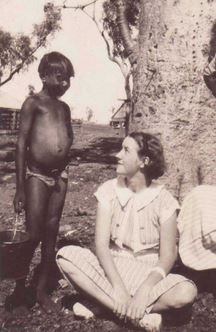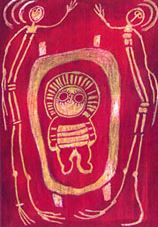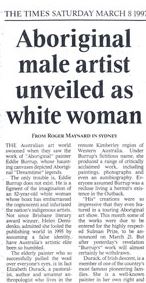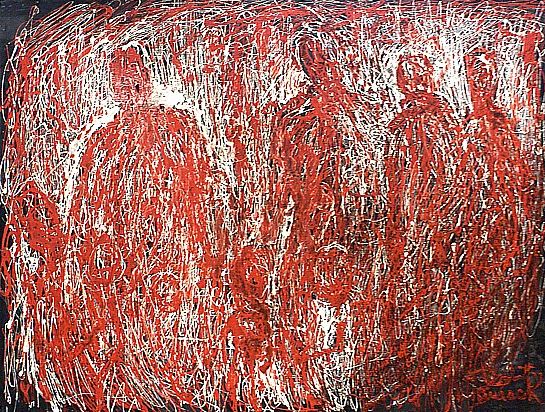
The Woman Who Was Eddie Burrup
Art and Life: Selected Writings
by Elizabeth Durack, edited by Perpetua Durack Clancy
Connor Court, 2016, 278 pages, $29.95
______________________________________
 Recently, while on holidays in the Eastern Kimberley, I visited the historic old Durack cattle station homestead. The building had been saved from the flooding of the Ord River and rebuilt block by numbered block above the level of the now resplendent Lake Argyle and its dam. Represented in the form of its early days, this homestead is a simple four-roomed building, surrounded by shady verandas and a pleasant enough garden. The interior is deliberately sparsely displayed by functionally identifying rooms rather than furnishing them, although a piano, that very symbol of civilised womanhood, was still there in its old spot in one room.
Recently, while on holidays in the Eastern Kimberley, I visited the historic old Durack cattle station homestead. The building had been saved from the flooding of the Ord River and rebuilt block by numbered block above the level of the now resplendent Lake Argyle and its dam. Represented in the form of its early days, this homestead is a simple four-roomed building, surrounded by shady verandas and a pleasant enough garden. The interior is deliberately sparsely displayed by functionally identifying rooms rather than furnishing them, although a piano, that very symbol of civilised womanhood, was still there in its old spot in one room.
Wandering idly around, I was suddenly stopped short in one room by an unframed copy (I presumed) of a small painting resting against a saddle, a painting that had impressive verve and impact, depicting in bold blue impressionist outlines two exultant stockmen, most likely Aboriginal, gleefully and expertly rodeo-jumping their wildly bucking horses. A dancing Matisse in composition, but oh so different too.
I was told it had been painted by Elizabeth Durack, the lesser-known sister of Dame Mary Durack, author of the famous book Kings in Grass Castles, which told of the early days of European settlement, when two Irish brothers set out from Queensland in 1883 in a great cattle drive overland from Queensland to the Northern Territory, ending up in Western Australia’s Kimberley region, claiming a massive amount of land along the Ord River valley and then elsewhere. Thus the two brothers became part of an elite group of white men, cattle barons over millions of acres each, kings of all they claimed.
I was also told that a book called Art and Life: Selected Writings had just been put together by Elizabeth’s own now elderly daughter and was soon to be launched (celebrated?) here at the Durack homestead. Intrigued by the little I knew of Elizabeth’s life, I purchased the book at the entry table, and read it later in my journey, under a boab tree, beside one of the Kimberley’s many free-running waterholes, beneath red cliff overhangs, which turned out to be a very fitting place. I knew nothing of either sister, nor their works, but did later purchase and read Mary Durack’s sequel to Kings in Grass Castles, aptly called Sons in the Saddle, published in 1983 with seven reprintings till 1998. In this book Mary continues the family saga down the generations and into the 1920s.
And what generations they are. We know that genealogies are exponential, well demonstrated in this one. From John Durack in County Galway, Ireland, came Michael and Darby. Good Catholics, Michael had eight children and Darby had thirteen. Not all survived, and every later generation in their large broods threw up their Michaels, Patricks, Bridgets, Marys and Johns, so keeping track of them all becomes difficult. After intermarriage with other local and then later elite city families, the consanguinity and affinity in total of the Duracks over time constituted a large Kimberley clan, with clan-like feelings for each other.
This essay appears in the current edition of Quadrant.
Click here to subscribe
Nicknames became common as a means of distinguishing the players. Mary’s sequel concentrates on the primary lineage, descending from Michael, via Patrick (Patsy) and then her father MP and his brother PB and their sisters Mary and Bridget. Her family’s history, thus also Elizabeth’s, is one of deals, of fights with major players like the Forrest Emanuel consortium over landholdings, and of the political game-playing about cattle tick in the Northern Territory being used by rivals to halt the Durack’s cattle imports; also about state politics, Federation, local politics and colourful identities, station managers and the networks of understanding required to control such large far-flung holdings. Mary presents an enduring record of life on the great cattle stations, in the late nineteenth and early twentieth centuries, in these early days considered “no place for a white woman”, although many came, and lost their lives and children to the prevalent fevers or their minds to loneliness.
Throughout it all there is the story of the Irish, and of the Catholic Aboriginal missions, which grew in numbers as requirements to offer wages to stockmen meant that whole extended families, supported by the stations as payment to stockmen, drifted into the missions when pastoralists felt financially forced to turn away from highly valued Aboriginal labour due to the extra costs their families entailed in addition to wage payments.
Irish families feature large in the Kimberley, as well as some younger sons of English aristocrats and gentry sent out to make their fortunes; as many did, while others descended into drunkenness, joining the drovers as bushmen, some speared to death by Aborigines, who were beginning to resist the loss of their traditional hunting grounds.
And so we come to Elizabeth, born in 1915, three years after Mary, and we come to me idly reading Elizabeth’s letters, diary entries, and rare published pieces; and wishing, really wishing, that the book contained some colour plates other than just black-and-white ones, for her paintings deserve appreciation, as she had always desired, in full colour, in their own right as art, and where better than in her book? Indeed, her daughter Perpetua’s stated reason for gathering together Elizabeth’s writing in sequence has been to restore Elizabeth (below) as an artist of some stature against charges of “cultural appropriation”, that intellectually deficient term by which Elizabeth was, as she had feared, hounded off the pages of Australian art history in the later years of her life and art. Elizabeth died in May 2000.
I think this book is thus an important one at this moment when strident calls about “cultural appropriation” are ringing in our poor assaulted ears from universities world-wide. Perpetua suggests there is another side to Elizabeth’s story; I write here to persuade you that Perpetua is right and to focus attention on this book, for it is the story of a feisty and deeply thoughtful woman’s artistic struggle to express in paint the beauty of the natural world in which she lived, imaginatively extending the extant cultural modes of a land and its Aboriginal people she loved, blending them seamlessly with her inherited European consciousness.
As elite young women, both sisters had been educated at the Perth Loreto Convent. Perhaps it is, as the younger sister of a childhood dominant one, that I identify so much with Elizabeth’s story, even though our circumstances were very different in terms of wealth and opportunity. Elizabeth spent her life trying to find her place, as I feel I have. She writes so well, better than Mary does. Mary is organised, literary, research-based, doesn’t wander onto tangents and you don’t get much sense of who she really was. Elizabeth’s writings are full of thoughts, ideas and explorations of feelings, and most of all she has a great sense of fun, of send-ups, and of terse assessments about political correctness and the idiocies of the art world. She should have written more, for her style is direct and contemporary.
She also wrote some poems, which are very expressive, sometimes amusing, often poignant, especially those reflecting an enduring theme in her life: that of being dumped by someone she loved, of going away overseas, hoping desperately to see him again on her return, but on return receiving a telegram saying that he had been killed in a car accident. It haunts her life and her dreamings; that death, that young man removed from life’s ambit. She marries, there are vague hints of lovers, and she ends her life in her eighties living alone, and still painting, about which she says:
It is extraordinarily difficult to reconcile painting and living. To live, one must compromise; to paint one must be so utterly ruthless that any sane person would see that the game is not worth the candle. Still it burns brightly and sweetly.
 She sought praise for “the essence” of art, art for itself, which in the sniping world of Australian contemporary art in the 1950s she, way out of the mainstream, didn’t receive, in spite of her helpful connections to the elite; one suspects perhaps even because of that. There is no better target for a leftist sniper than a cattle baron’s daughter.
She sought praise for “the essence” of art, art for itself, which in the sniping world of Australian contemporary art in the 1950s she, way out of the mainstream, didn’t receive, in spite of her helpful connections to the elite; one suspects perhaps even because of that. There is no better target for a leftist sniper than a cattle baron’s daughter.
Something of a mystic, Elizabeth (at left in her youth) communed with the natural world of the Kimberley. The stones and rock, the colours, the old Aboriginal men and women, were at the heart of her longings, and she wanted to represent it all as she experienced it growing up. Her picture of the bronco riders that first caught my attention showed this. She would often go out for whole days into the bush, to think and pour into her soul the world around her. She called it her “tendency”. Her tendency “to take off”, by which she also meant a “taking off” of the spirit. Love of this harsh but overwhelmingly present, almost insistent, country, getting it under your skin, returning against all reason at times, was something that happened to many of the early settlers, especially the stockmen, out in it; and the Duracks were stockmen through and through.
As early as 1947, in a letter to her adored brother Reg, she writes of grass, a defining feature of the landscape:
The whole character of dealing with this land is through the treatment and portrayal of its grass.
Oh, I am tired of human beings. Every face that screams its awful message at me—how can one ever hope to attain to the formal and the pure if one deals with human faces. Look at me, love me, hate me, fear me, pity me, feed me, bury me, faces say things all the time. I am tired of all that can said by a human face. I know every inflection of its contours, every fleeting transient thought that darts like fish through the open windows of the eyes, the little fears, the little scorn, the little hope, but grass says nothing. It just folds and unfolds itself, leans and turns in a glory of formal patterning, leaps suddenly skyward in a crescendo of excitement.
Elizabeth Durack ‘Wildgrass’ (1961)
Elizabeth took those feelings seriously, artistically. She saw the art of the Aborigines and “knew” it. Her work started to contain elements of Aboriginal style, just as her earlier work drew on the art of Europe, and as she pointed out, just as European artists had drawn on the work of Japan, or a range of other cultures. She was a “skin sister” with old Aboriginal women and friends with old Aboriginal men. She learned more and more of their culture, their art, and moved from a type of impressionist portraiture (at which she excelled) to fall under the influence of the old Aboriginal men with whom she painted. In 1954 her series called “Love Magic” made a stylistic break. In this series, she used Aboriginal concepts like “Drawing Death”, a bony hand such as was never painted by any Aborigine, pulling death out of the body, using a mix of European and Aboriginal imagery; the “look” was increasingly Aboriginal, but it was different, very different.
Picasso and Miro could “move back” into the reaches of European imagery (Guernica shrieks of it; Miro’s “birds, women, stars” are almost identical to images I saw on ancient pottery in the Museum of Barcelona), but Elizabeth was savaged by the critics for her similar emotive reach in what she saw as her own country and landscape; that world she saw as owned by totems, not by people. She held her ground against the severity of critics, and was disliked for scornfully fighting back in print. Her 1975 Flightless Birds Achieve Lift Off shows within it her move from realism to abstraction and her 1996 Ladder to the Sky is entirely remarkable. It is now curated under the series “The Art of Eddie Burrup”.
 For Elizabeth had become by then, in her mind, at one with the cultural imagery that was flooding into her. She became Eddie Burrup. She painted her own works as Eddie Burrup. They were hers artistically. She named them in Eddie Burrup’s voice, as in a Christmas card (right) she designed, “Two fella angel ’e singin’ out for lovlybaby Jesus ’la haytrough”, and there is baby Jesus as a baby Wandjina, a white line-spaced Wandjina halo encircling his Wandjina spirit head, lying in a wooden bowl, with skeleton Wandjinas watching over him. Eddie Burrup and his many paintings became an overnight sensation. Elizabeth did not dissemble to herself, for she saw it as transformative. Eddie Burrup was part of her, she “heard” him, he took over her painting at times, and he was showing that art could be seen simply for itself, as her art.
For Elizabeth had become by then, in her mind, at one with the cultural imagery that was flooding into her. She became Eddie Burrup. She painted her own works as Eddie Burrup. They were hers artistically. She named them in Eddie Burrup’s voice, as in a Christmas card (right) she designed, “Two fella angel ’e singin’ out for lovlybaby Jesus ’la haytrough”, and there is baby Jesus as a baby Wandjina, a white line-spaced Wandjina halo encircling his Wandjina spirit head, lying in a wooden bowl, with skeleton Wandjinas watching over him. Eddie Burrup and his many paintings became an overnight sensation. Elizabeth did not dissemble to herself, for she saw it as transformative. Eddie Burrup was part of her, she “heard” him, he took over her painting at times, and he was showing that art could be seen simply for itself, as her art.
She was used to pseudonyms. She had written, under the pseudonym “Ted Zakrovsky” (Quadrant, April 1984), about the dire situation of Aboriginal people under the “new enlightened” policies that were creating Third World conditions for Aborigines, destroying them by dependence, by humiliation, by giving them no place in white society. She wrote again in Quadrant (February 1985), under her own name, her “Essay on Land Wrongs”. She was clear to her daughter, an art dealer by this time, that Eddie Burrup was no Ern Malley. She was not mocking anything but the fact that it was who the artist was, rather than his/her art,  that seemed to matter to the critics. She called them her “morphological” works; “an experiment—not a hoax—not a crime”.
that seemed to matter to the critics. She called them her “morphological” works; “an experiment—not a hoax—not a crime”.
The full force of “cultural appropriation” came down upon Elizabeth’s head. She had intended the story of Eddie Burrup to emerge slowly, but it broke all at once in 1997, in a storm of criticism, and she had to face the fact that her Burrup works were “unpublishable” in any artistic context. At a conference in Canberra in February 2000 on “Masquerades and Identities—the Colonisation of the Soul”, a paper by a Dr Christine Nicholls declared that the eighty-five-year-old Elizabeth was “commodifying the artist as an individual” in order to “authenticate” herself by “a discourse acting in the service and salvation and redemption of a particularly unremarkable artist”. So unfair, because Elizabeth’s paintings under the influence of Aboriginal dreamings (her “Eddie” who took over her soul) are completely and authentically hers; wonderful works. At this stage Elizabeth declared her resistance to “going headfirst into a melee of demented women blue stockings”, and who could blame her? Buy the book and see her works and read of her times for yourself.
I hope Perpetua’s book does something to restore to full recognition Elizabeth’s later paintings and her deep sympathy for Aboriginal imaginings, cementing too her place in the legends of the Kimberley Duracks. Her earlier works are now collectible: some are here on display where I write this, in the Cable Beach Club Resort in Broome, where four large “late” Nolans also hit you in the eye behind the long reception desk, impressively atavistic Nolans, but not treated by the art world like Elizabeth’s atavisms. Her Eddie Burrup (how like Durack that sounds) paintings seem still suspect in some way, simply part of Elizabeth’s estate (those in the book anyway), held in trust by her daughter, although they have been exhibited in London.
The cultural appropriationist thought police will doubtless be out in force against this gentle visionary, even now.
In 1999, her poem called “Anniversary of a Death” recalls her life’s deepest grief:
All we were needing
was a quiet farewell—
but no—
you wrenched
the Hour Glass
from the hand of Time
and smashed it—
glass slivers
flying everywhere
—oh—
I am bleeding.
She had had a falling out with Mary. The very day that Elizabeth died she wrote:
The beginning
the beginning to the end
there is no end
but a loop
Mary and Elizabeth together
it is not so hard …
Elizabeth is buried next to Mary in the garden of the Durack homestead in the East Kimberley, among the graves of some others of her lineage.
Elizabeth Beare lives in Sydney and has worked as a copywriter and academic.
Madam: Archbishop Fisher (July-August 2024) does not resist the attacks on his church by the political, social or scientific atheists and those who insist on not being told what to do.
Aug 29 2024
6 mins
To claim Aborigines have the world's oldest continuous culture is to misunderstand the meaning of culture, which continuously changes over time and location. For a culture not to change over time would be a reproach and certainly not a cause for celebration, for it would indicate that there had been no capacity to adapt. Clearly this has not been the case
Aug 20 2024
23 mins
A friend and longtime supporter of Quadrant, Clive James sent us a poem in 2010, which we published in our December issue. Like the Taronga Park Aquarium he recalls in its 'mocked-up sandstone cave' it's not to be forgotten
Aug 16 2024
2 mins









